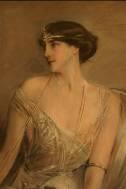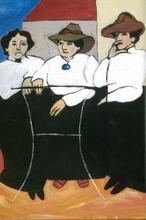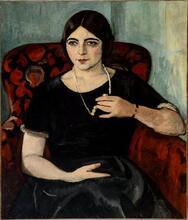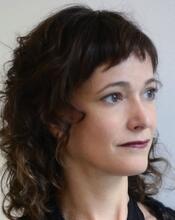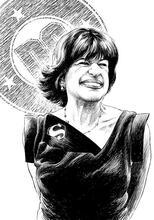Etta Wedell Mastbaum
Etta Wedell Mastbaum’s collection of Auguste Rodin’s sculptures, letters, and memorabilia helped preserve the artist’s work for generations to enjoy. While travelling in Europe with her husband, the couple fell in love with and began collecting Rodin’s work from each stage of his career, so as to create a full picture of his life and artistry. Based on her collection, one of the largest Rodin collections in the world, Mastbaum opened a lavish museum in Philadelphia in 1929 and was decorated by the French government for her work in honoring the sculptor. After her husband’s death, Mastbaum ran his business, served as an executive of Lit Brothers (a department store her mother and uncles had founded in Philadelphia), and ran several local charities.
Etta Wedell Mastbaum was the scion of a prominent nineteenth- and twentieth-century Philadelphia family. A philanthropist, department store executive, art collector, and director of a national chain of motion picture theaters, Mastbaum donated a collection of Rodin sculptures and ephemera to the city of Philadelphia.
Early Life and Education
She was born Etta Lit Wedell on September 6, 1886, in Philadelphia, the daughter of Rachel Lit and Philip M. Wedell. Mastbaum’s mother established a modest dress and millinery shop in Philadelphia in 1891. With her brothers, Samuel and Jacob Lit, the store expanded and became Lit Brothers Department Store, occupying an entire city block in a new building constructed in 1906. The store was sold in 1928, with the Lit family continuing in an executive role. By the 1960s, Lit Brothers was the largest department store chain in the region.
After graduating from high school, Etta attended the Philadelphia Seminary for Women. On January 19, 1904, she married Jules E. Mastbaum, a proprietor of a chain of motion picture theaters stretching from New York to West Virginia. The marriage was a union of two prominent Philadelphians.
Collecting Rodin
Traveling in Europe in 1924, the Mastbaums discovered the work of sculptor Auguste Rodin. After convincing the curator of the Musée Rodin to sell them a small bronze piece, the Mastbaums’ interest in Rodin led to many acquisitions of sculptures in bronze and plaster, bas-reliefs, drawings, ephemera, books, and letters written by Rodin. Acquiring items representing each phase of Rodin’s career, Etta and Jules Mastbaum sought to create a collection that would provide a comprehensive view of Rodin’s life and work. Their collection became second only to Rodin’s own donation to France at his death in 1917.
The Mastbaums were given permission by the government of France to amass this collection with the provision that the objects be exhibited in a permanent structure open to the public. Thus, Jules Mastbaum wrote to the commissioners of Philadelphia’s Fairmount Park, offering to build a museum and provide funds to maintain the collection as long as it could be housed there. Permission was granted, and Jules Mastbaum commissioned French architect Jacques Gréber, designer of the Benjamin Franklin Parkway, to work with the Philadelphia firm of Paul Cret in designing a beaux-arts structure to house the collection.
While the French Art Commission sought assurance that the collection would be publicly displayed, there was no requirement that the collection itself be owned by the public. But Jules Mastbaum’s unexpected death in 1926 led Etta Mastbaum to donate the collection in its entirety to the people of Philadelphia. Dedicated in 1929, the gift by Etta Mastbaum and her daughters Louisette, Margery, and Elizabeth to the city of Philadelphia in honor of Jules E. Mastbaum helped establish that city as the most important center for the study of nineteenth- and twentieth-century French sculpture in the Americas. Prior to the death of Jules Mastbaum, the Mastbaum family funded repairs to Rodin’s house and studio at Meudon, and donated a bronze cast of Rodin’s Gates of Hell. Never cast in the sculptor’s lifetime, Gates of Hell was considered one of Rodin’s most important works. For these efforts, Etta Mastbaum was decorated by the government of France.
Legacy
After her husband’s death, Etta Mastbaum assumed control of his business and financial interests. A director of the Stanley Company of America, she also served her family’s interest as an executive of Lit Brothers. As second vice president of the Mastbaum Loan System, a society providing financial assistance to the needy, Etta Mastbaum furthered her husband’s memory. She was also active in the Red Cross and in Emergency Aid of Philadelphia and was a member of Philadelphia’s Congregation Mickve Israel.
Etta Mastbaum died in New York City at her residence in the Waldorf Towers on November 1, 1953, at age sixty-seven.
EJ, s.v. “Lit family”;
Obituary. NYTimes, October 3, 1953, 17:6;
Riopelle, Christopher [associate curator of European painting before 1900, Philadelphia Museum of Art]. Interview with author, June 1996;
Tancock, John L. The Sculpture of ... Rodin (1976);
Tschirch, John [architectural historian, Preservation Society of Newport County]. Interview with author, June 1996;
Watkins, Fridolyn G., comp. Catalog of the Rodin Museum of Philadelphia. Rodin Museum of Philadelphia (1929);
WWIAJ (1928).

